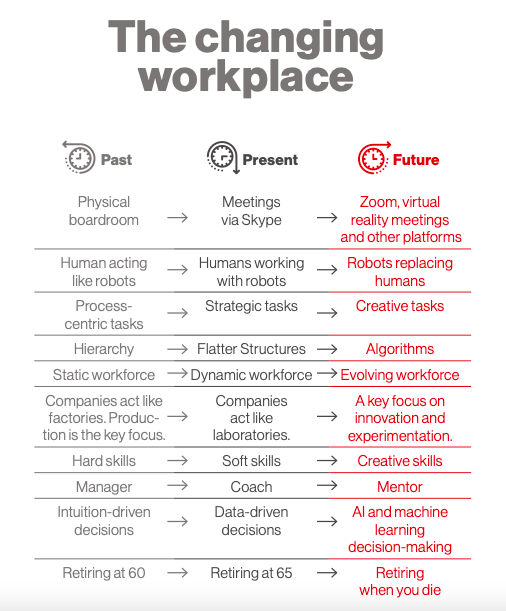Trade unions and trade union negotiators are not powerless when it comes to influencing the future of work and shaping the reality of work.
Technological change and the reorganising of production often happen little by little over a period of time. There can also be sudden leaps in the application of technology to production and the organisation of work. There are many different factors that decide the speed and scale at which an industry, sector or enterprise will adopt new technologies.
Technological change and informalisation are closely linked under the fourth industrial revolution.
Digital technology, in a variety of forms, is one of the central drivers of change in modern economies. Even so, in a survey of large and emerging multinational employers, the most significant driver of change was identified as “Changing work environments and flexible working arrangements”.
This refers, in part, to new technologies enabling workplace innovations such as remote working, co-working spaces and teleconferencing. The OECD says that organisations are likely to have an ever-smaller pool of core full-time employees for fixed functions, backed up by colleagues in other countries and external consultants and contractors for specific projects.

This leads us into the second central feature of the future of work – the erosion of the standard employment relationship and the shift to a more flexible, externalised and contractualised relationship.
Companies moved to externalise the so-called non-core functions of an enterprise decades ago. In a single workplace, you can now find many different forms of employment, including full-time permanent, permanent part-time, contract workers and workers supplied by temporary employment services.
These are the broader challenges that a trade union negotiator faces.
Collective bargaining and workers’ voices can help address the challenges posed by a changing world of work. As demographic and technological changes unfold, collective bargaining can be used to mediate adjustments in wages, working time, work organisation and tasks to respond to new needs in a flexible and pragmatic manner.
Collective bargaining can help to shape new rights, adapt existing rights, regulate the use of new technologies, provide active support to workers transitioning to new jobs and anticipate skills needs.
Collective bargaining can be used to protect workers from the worst impacts of informalisation and technological change.

Source: LRS Negotiator’s Guide (2022)
6 bargaining strategies for the future
1. Develop our own knowledge base on the future of work
Find out what technology is being used in the company. Demand that the company disclose what technologies they are currently using and what technologies they are considering deploying. Try to add a clause to the main agreement that commits the company to consulting with the union prior to implementing new technologies.
Begin to learn about the key technologies and trends in your industry and sector. There is no substitute for developing our own knowledge. This is the foundation for developing strategies to cope with new technology and for reorganising work in our industries and sectors. Workers and their representatives know a great deal already – sometimes the challenge is simply surfacing that knowledge, recording it and beginning to structure it.
Resource: The Future of Retail in Africa
2. Negotiate for precarious workers
Organising workers in non-standard employment can be difficult. It might be easier for the union to try to represent the interests of non-standard workers in collective bargaining first. The union will have a better chance of organising these workers if it can show that it is already trying to represent them.
As a trade union movement, we simply must push for the equalisation of pay and benefits for part-timers, contract workers, fixed-term workers, flexi-timers and workers of temporary employment services used by the company. If we do not, then we are helping to establish a pool of cheap workers that the company will be incentivised to use.
You can monitor compliance by the company using Chapter 9 of the Labour Relations Act – the Regulation of Non-Standard Employment and General Provisions. The sections of interest are (198) Temporary Employment Services, (198B) Fixed-term contract workers, (198C) Part-time workers, and (200A) Presumption of who is an employee.
Section 198(5) of the LRA states that two bargaining councils may bind parties to the agreement that fall within their combined scope. This might be a way of raising the standards for workers in precarious jobs by linking them to the standards set out in the main agreement of a bargaining council.
3. Look and listen for new issues in the workplace
A negotiator must be able to recognise new issues that are of importance to workers. Examples of this include the negative consequences of remote work and health and safety issues in the workplace in the context of the Covid-19 pandemic.
Read: Behaviour change in the workplace – Health and safety training manual for union educators
4. Technology for trade unions – Beneficiate our own resources
The union/workers’ organisation can utilise technology in order to grow the organisation itself, as a platform for protest, to form e-unions, virtual unions and to improve strategies. This is already evident in the way that some unions are using WhatsApp and Social Media to spread their messages. There are many possibilities. In what simple ways can you use technology to be a better negotiator?
Trade unions can bring modern data technology to bear on their own operations, to mine strategy from their membership data and to magnify their possibilities for communication with worker members.
5. Develop communications with members
Communication is fundamental to negotiations. A negotiator needs to be in contact with workers before, during and after negotiations. Do you have ways of communicating with workers that do not rely only on face-to-face contact? Some trade union affiliates of BWI in Africa developed communication strategies during the early phases of the COVID-19 global pandemic. The union set up and allowed WhatsApp groups to be formed at different levels in the union by the trade union representatives at those respective levels.
They began by establishing groups involving trade union leadership and officials covering the key companies, sectors and areas. Worker leaders could then initiate groups at the workplace and local level. Worker leaders and officials would better know who to invite, and the group could potentially grow as workers invite their fellow workers to join.
Resources like smartphones, mobile data and training may be required to assist trade union representatives to achieve effective communication strategies. It would be money well spent, and would provide the union with a robust and relatively cheap communication channel – even under the extreme conditions of a hard lockdown.
Read: Practical suggestions for emergency online solutions for trade unions.
6. A simple framework for future strategies
Traditionally, trade unions would have focussed on issues such as wage increases, benefits and working conditions in collective bargaining, although they are no stranger to pushing a national agenda for change.
Automation in the workplace will require an increased focus on issues relating to “education, training, and legal support in an increasingly complex environment”. If the fourth industrial revolution is to result in a positive effect on employment, the skills and re-skilling of the workforce will have to be a core focus of the trade union movement.
Trade union campaigns for national debates could ensure the required skills transition or relevant protection and compensation measures.
Four ILO recommendations for preparing for the future of work
- Lifelong learning for all.
- Supporting people through transitions.
- A transformative agenda for gender equality.
- Strengthening social protection for all.

Source: LRS Negotiator’s Guide (2022)
READ: “Negotiating the Future of Work” resource, to know more about:
- Predictions for technological innovations in the developing world
- The future of jobs
- Responding to informalisation
- Real-world examples of trade unions grappling with non-standard employment
- Global pandemics and the future of work
- Campaigns to influence policy formulation







